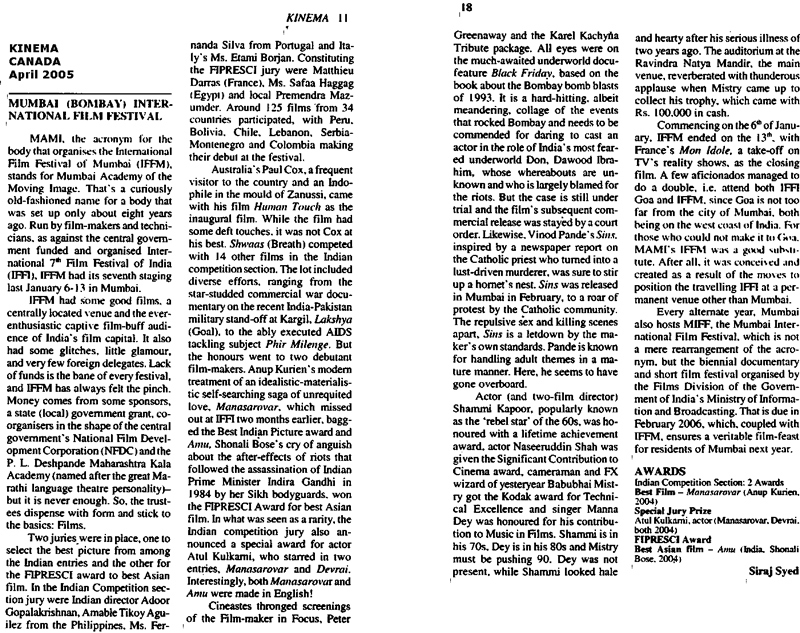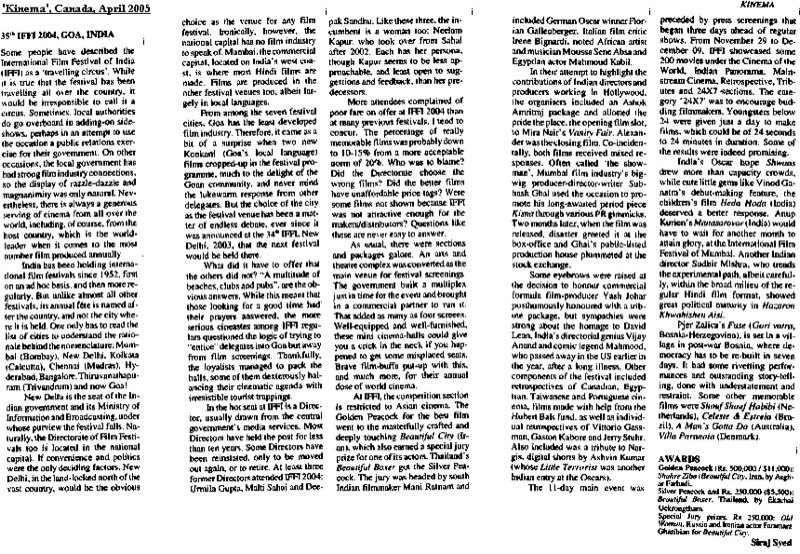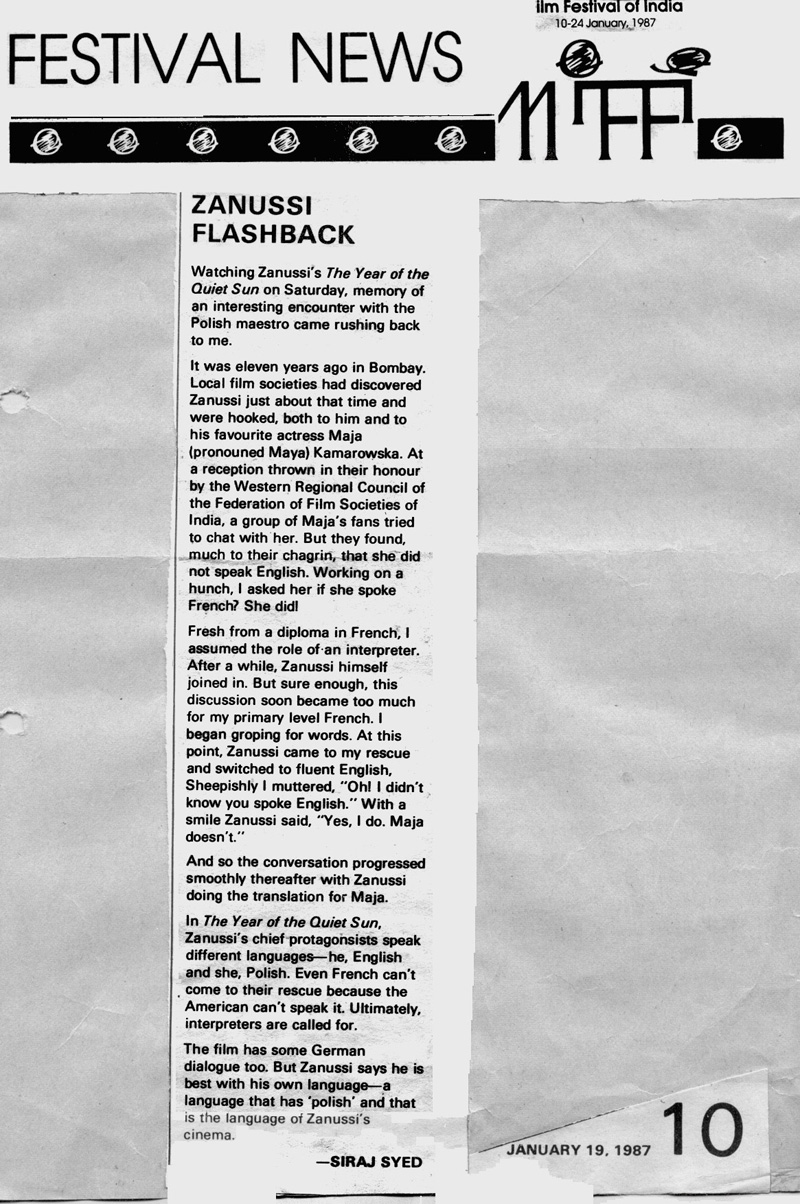|
|
||
|
Pro Tools
FILMFESTIVALS | 24/7 world wide coverageWelcome ! Enjoy the best of both worlds: Film & Festival News, exploring the best of the film festivals community. Launched in 1995, relentlessly connecting films to festivals, documenting and promoting festivals worldwide. We are currently working actively to upgrade this platform, sorry for the inconvenience. For collaboration, editorial contributions, or publicity, please send us an email here. User login |
Siraj SyedSiraj Syed is the India Correspondent for FilmFestivals.com and a member of FIPRESCI, the International Federation of Film Critics. He is a Film Festival Correspondent since 1976, Film-critic since 1969 and a Feature-writer since 1970. He is also an acting and dialogue coach. @SirajHSyed  Bastar-The Naxal Story, Review: GhostBastar
Bastar-The Naxal Story, Review: GhostBastar Conflict has been raging at India’s borders for decades and decades. India-China and India-Pakistan borders are conflagration points since the last century, and Kashmir is a region which India claims as its own, while insurgents align themselves with Pakistan. We also face conflict in the North-East, where there are separationists in action. But the largest conflict is between Maoists (Communist Party of India, Marxist-Leninist), known as Naxalites, and the Indian state. This ‘war within’ has claimed more lives than all the other conflicts combined. From the forests and mountains of Kerala to Maharashtra to Madhya Pradesh to Chhatisgarh to Andhra Pradesh to Telangana to Orissa to Jharkhand to West Bengal, there are an unknown number of anti-Indian elements that salute the Communist flag and punish those who respect the Indian national flag. This film is a docu-fiction that suggests that a coterie of vested interests - millionaires, TV channels, lawyers and more - funded and backed the movement. A thorn in their flesh was Policewoman Neerja Madhavan, the Indian Police Service (IPS) officer of the region, who often eliminated elements that challenged authority. An organisation, known as Salwa Judum, was formed by the powers that be to counter the terror, with civilians enrolled as Special Police Officers (SPOs). But the Naxalite network was so far spread out that her resources were not enough to battle them. After they mercilessly executed a suspected police informer and chopped his body to bits, his wife swore revenge and joined Neerja’s forces. Unfortunately, her own young son was swayed by the Naxal ideals, and became a Naxalite. When the Naxalites mounted an attack on 76 Central Reserve Police Force (CRPF) personnel, Neerja asked for back-up, but her plea was denied. As a result, all the jawans (cadre) ere short and then their camp was set afire. This barbarous act made the pregnant Neerja swear vengeance, and she went out, with the support of elite Cobra commandos, gunning for the perpetrators. The ‘war widow’, now a trained killing machine, went with her. Getting a scent of her all-out assault, the Naxal leader, who had led the attack on the CRPF, decided to leave for safe haven in another state. Bastar, the movie, is so-called because the place called Bastar, now located in the state of Chhatisgarh, is perceived as the head-quarters of the ‘revolutionaries’. The events depicted in the film are largely taken from incidents that occurred in Bastar in 2007. Most of the revolutionaries are Adivasis (modern-day aboriginals), who are convinced that successive Indian governments, in cahoots with moneybags, is out to drive them away from their homes, because the land that they inhabit is rich in minerals. Roots of the armed resistance can be traced to an armed uprising against big landowners, which began from Naxalbari, a small village in north Bengal. The peasants of Naxalbari, had, for centuries, been exploited by the landowning classes. When a peasant named Bighul Kissan was attacked by a landowner, on 24 May 1967, a horde of policemen came to Naxalbari, to look into the matter, and a mob attacked the cops. A police officer died in the incident. The next day, the police opened fire at a krishak sabha (farmers’ meet) and 11 people were killed. Following this, the uprising spread like a wildfire in the region, with Kanu Sanyal, a former court clerk, at its helm. Although the movement was crushed by then chief minister of West Bengal, the Naxalbari movement caught global attention. Even peasants from other states got influenced by the uprising. Kanu Sanyal and Charu Majumdar formed the Communist Party of India (Marxist-Leninist) in 1969. Bastar-The Naxal Story does not touch this background at all, though its poster says, “100 Years of Communism and100 million Dead”. It is crystal clear that the film is pro-government, even if some of the ministers and executives are shown as corrupt and profiteering from the warfare. It is also clear that the film roundly condemns NGOs, media, lawyers and funders, for secretly funding and harnessing Naxalites. But it fails to assign any reason why all of them are conspiring to let the Naxalites control the areas, rather than the police and the CRPF, when the rich lobby is waiting to get them out and dig into the ‘gold’mines of the region, with the help of the government. It seems counter-productive. Although Vipul Amrutlal Shah is playing a triple role here – as writer, producer and creative director, the script is credited to three gentlemen: Amarnath Jha, Sudipto Sen and Vipul Amrutlal Shah. Of these, Jha, for sure, comes from a state that has had Naxal terror issues for a very long time – Bihar. Amarnath Jha is a film-maker, film-writer and theatre activist. Jha was born at Jhanjharpur, Mithila, Bihar. Jha started his journey as a film-maker in Mumbai, around 2002. With time, his cinematic skills evolved. He also got opportunity to work with theatre legend Habib Tanvir and Usha Ganguly. Vipul and Sudipto co-directed Vipul’s 2023 release, The Kerala Story, which, too, had three writers, one more besides the duo. Adah Sharma (playing the Ghost-Bastar Neerja, was the lead in The Kerala Story too)
and Vijay Krishna (the antagonist in both films), find themselves in Bastar too. Both are asked to do little, besides unleashing volleys of bullets or carving out human flesh. In one interesting twist, Adah is discovered to be pregnant, but does not let her pregnancy come in the way of duty.
Incidentally, one source gives her real name as Chamundeswari Iyer and her mother tongue as Tamil, while her parents’ names are S.L. Sharma and Sheila Sharma! And Vijay, who is an expert butcher of the human body, gets the heebie-jeebies when he senses that the end could be nigh. Adah’s character needed more fleshing out to be impressive, and the same goes for Vijay, who is shown to have the barest hint of carnal pleasure before the scissors get into the act.
It would be surprising if there were no corrupt politicians in this kind of film, and, it would be even more surprising if the film did not depict NGOs, select media and lawyers as being lock stock and barrel in cahoots with the bad guys, because this would appease the present political regime. So, there they are. Home Minister Prabhat Kumar (Anupam Joardar), Shilpa Shukla (Defence Counsel), Raima Sen and Anangsha Biswas (bimbettes), Narayan Bagchi (money ‘bag-chi’ Purnendu Bhattacharya, in an underplayed portrayal). Shilpa shows great command over English and convinces as the Advocate. The others are merely for décor. As Shilpa’s opponent in court, Yashpal Sharma is wisely given very few English dialogue and manages to infuse the stock character of an Advocate with some life. Kishore Kadam never falters, and here, too, as Rajendra Karma, the Chief of Salwa Judum, slides into the role seamlessly.
Indira Tiwari (Aarakshan, Nazarband, Serious Men and Gangubai Kathiawadi) is cast as the woman whose husband is butchered before her eyes and has to carry his body parts home. It’s an over the top performance, but what else would you expect from a woman who has been through this ordeal? Two other actors catch the eye: Subrat Dutta as the loyal Indian citizen who pays the most horrendous price for his nationalism, and Gopal Singh as Neerja’s civilian lieutenant. Gopal is always a treat to watch, even in a poorly etched road. Sadly, none of the other major players could be identified. Writing a film like this involves months/years of research, and maybe they did do all that. Then you have tomes and piles of documents that you must sift through to pick the most representative incidents. And, lastly, you then have to weave all of that into a screenplay. Bastar-The Naxal Story gives you a snapshot of the ground reality. It is where they have taken cinematic liberty that you feel they should have done a better job. Especially the end, which is so contrived. Dialogue, because of the recurring shifts from Hindi to English to local dialects, with sub-titles, of course, fails to impress. It is too simplistic to be memorable. Granted that illiterate adivasis would not have much use for idiomatic expression, there was still scope for raising the bar. Since the screenplay focusses on encounters between the Naxals and the law, there is a constant barrage of ammunition for about three-quarters of the film. Don’t blame the makers for the butchery and the flinging of a child into fire - they warned you just after the opening credit titles that the film contains some very gruesome and disturbing scenes, and, though it is certified for exhibition to Adults Only, you were advised to use discretion in choosing what not to see. You had the option of closing your eyes or leaving the auditorium when these scenes came on. The film is not for the weak-hearted. While on ‘closing your eyes’, you should also close your eyes when a round table is convened, with representatives from ISIS, LTTE, Boko Haram and terrorist groups from Indonesia and the Philippines, all of who have come to India to express solidarity with the Naxals. They are introduced at a round-table to the Naxal Supremo. Don’t tell me he did not know they were coming! Incidentally, where did the Naxals get crores of rupees and latest arms and ammunition? How did it get into the country? Million-dollar question! Though rooted in history, Bastar-The Naxal Story is an agenda film. Director Sudipto Sen lays it bare when the Naxals insist in having their own flag and severely punish anybody to salutes the Indian flag. Not many films have gone that far. His casting is good. As he would have known from the beginning, there are several parties to the conflict: the Naxals, the innocents, the police, the CRPF, the local government, the Salwa Judum, the central government, and international terrorist organisations. It would take some genius to roll out a picture that gives you the correct mix of the various vested interests, as well as tell a human story about a pregnant, dedicated policewoman, who will go any lengths to try and eradicate the menace (little is seen about her husband); a widow, who vows revenge, and takes up arms, even as her only son joins the terrorists. It is a tall claim when Neerja keeps telling the widow that she will find her son and that no harm will befall him. For the oldish widow to become a crack-shot and accompany Neerja on all her missions, seems far-fetched. Patriotic songs are an essential part of any such rousing film, and there are a few. By definition, they are sung at high pitch. The composer is Bishakh Jyoti. Cinematography by Ragul Dharuman explores the terrain and the captures the various fires quite well. At two hours four minutes, editor Dev Rao Jadhav has probably left out some content that could help build a better narrative, in the interest of keeping it short. Only guessing, though. Not entirely an agenda film, Bastar – The Naxal Story does educate the under 40s about something that they know only superficially. To those who have been reading newspapers through the 60s to the 2000s, it might have little by way of newness. That the ideology is spread over such a large tract of land and there does not seem any solution in sight is undoubtedly cause for concern to any Indian. To end this review, I would like to remind readers that the military and air-force was not and cannot be used against these villagers, who are our own citizens, one more crucial factor that the film failed to highlight. Rating: ** Trailer: https://youtu.be/5KfJWVcnbdI ------------------------------------------------------------------------------------------ 43 years ago, in 1980, writer-director Khwaja Ahmed Abbas, made a film called The Naxalites. This was one of those rare films where he cast a popular actor in a lead role. Mithun Chakraborty was the hero of the film. It had been said about Mithun that he did flirt with Naxalism while he was in Bengal, and came to Mumbai to get out of the system. Here, he performed stage shows under the name of Rana Rez, before bagging film roles. The lead actress was Smita Patil, who would fit into any K.A. Abbas set-up qute naturally. 15.03.2024 | Siraj Syed's blog Cat. : Adah Sharma Charu Majumdar Gopal Singh Indira Tiwari Kanu Sanyal Kishore Kadam Naxalbari Purnendu Bhattacharya Raima Sen Salwa Judum Shilpa Shukla Sudipto Sen Vijay Krishna Vipul Amrutlal Shah Yashpal Sharma
|
LinksThe Bulletin Board > The Bulletin Board Blog Following News Interview with EFM (Berlin) Director
Interview with IFTA Chairman (AFM)
Interview with Cannes Marche du Film Director
Filmfestivals.com dailies live coverage from > Live from India
Useful links for the indies: > Big files transfer
+ SUBSCRIBE to the weekly Newsletter DealsUser imagesAbout Siraj Syed Syed Siraj Syed Siraj (Siraj Associates) Siraj Syed is a film-critic since 1970 and a Former President of the Freelance Film Journalists' Combine of India.He is the India Correspondent of FilmFestivals.com and a member of FIPRESCI, the international Federation of Film Critics, Munich, GermanySiraj Syed has contributed over 1,015 articles on cinema, international film festivals, conventions, exhibitions, etc., most recently, at IFFI (Goa), MIFF (Mumbai), MFF/MAMI (Mumbai) and CommunicAsia (Singapore). He often edits film festival daily bulletins.He is also an actor and a dubbing artiste. Further, he has been teaching media, acting and dubbing at over 30 institutes in India and Singapore, since 1984.View my profile Send me a message The EditorUser contributions |































